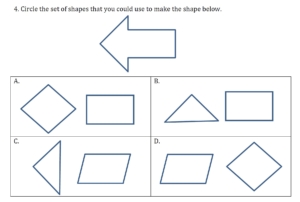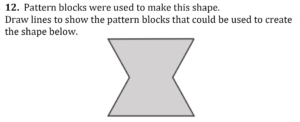MAFS.1.G.1.2 Compose two-dimensional shapes (rectangles, squares, trapezoids, triangles, half-circles, and quarter-circles) or three-dimensional shapes (cubes, right rectangular prisms, right circular cones, and right circular cylinders) to create a composite shape, and compose new shapes from the composite shape.
Cognitive Complexity Level: 1-Recall
[divider] [/divider] Students are able to…
- Identify the name of the composite shape and the shapes that form it
- Create new composite shapes
- Solve shape puzzles
[divider] [/divider] Students are able to…because teachers:
- Provide opportunities for students to create new composite shapes
- Facilitate conversations to use vocabulary to identify shapes and the new composite shapes
[divider] [/divider] Questions to ask students:
- Ask: What new shape can you make if you combine 2 triangles?
- Sample answer that indicates understanding: If I use 2 triangles I can create a rectangle.
- Ask: Use your geoboard to create a shape that has 3 triangles and 2 squares
- Sample answer that indicates understanding: Student creates a shape that is made of 3 triangles and 2 squares.
[divider] [/divider] Additional Resources:
Additional in depth content knowledge
Video: Khan Academy – Shape Collection
https://www.khanacademy.org/math/cc-1st-grade-math/cc-1st-measurement-geometry/modal/v/sides-corners
[divider] [/divider] Sample Formative Assessment Tasks:
[divider] [/divider] Resources/Tasks to Support Your Child at Home:
- Students can create their own Shape Mosaic. Be sure to have your child name the shapes they are using and the shape they are creating. https://www.education.com/game/create-mosaics-with-shapes/
- Task: Give your child a rectangular paper or draw a rectangle. Have them decompose the rectangle different ways. Encourage them to decompose different ways with the same shape. Continue process with other shapes.
- Task: Have your child name the shapes that were used to decompose the original shape.

